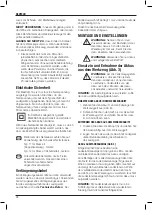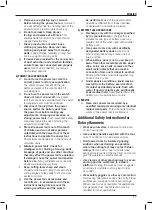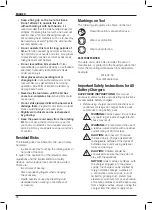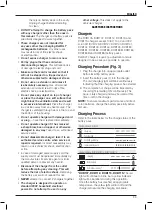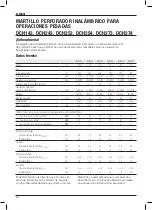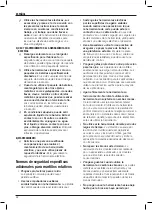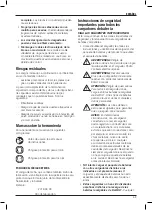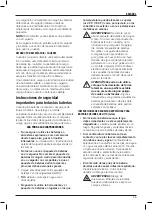
41
english
life, store battery packs at room temperature
when not in use.
2. For long storage, it is recommended to store a
fully charged battery pack in a cool, dry place
out of the charger for optimal results.
NOTE:
Battery packs should not be stored
completely depleted of charge. The battery pack will
need to be recharged before use.
Labels on Charger and Battery Pack
In addition to the pictographs used in this manual,
the labels on the charger and the battery pack may
show the following pictographs:
Read instruction manual before use.
See
Technical Data
for charging time.
Battery charging.
Battery charged.
Battery defective.
Hot/cold pack delay.
Do not probe with conductive objects.
Do not charge damaged battery packs.
Do not expose to water.
Have defective cords replaced
immediately.
Charge only between 4 ˚C and 40 ˚C.
Only for indoor use.
Discard the battery pack with due care
for the environment.
Charge
D
e
WALT
battery packs only with
designated
D
e
WALT
chargers. Charging
battery packs other than the designated
D
e
WALT
batteries with a
D
e
WALT
charger may make them burst or lead to
other dangerous situations.
Regulations, International Maritime Dangerous
Goods (IMDG) Regulations, and the European
Agreement Concerning The International Carriage
of Dangerous Goods by Road (ADR). Lithium-ion
cells and batteries have been tested to section 38.3
of the UN Recommendations on the Transport of
Dangerous Goods Manual of Tests and Criteria.
In most instances, shipping a
D
e
WALT
battery pack
will be excepted from being classified as a fully
regulated Class 9 Hazardous material. In general, the
two instances that require shipping Class 9 are:
1. Air shipping more than two
D
e
WALT
lithium-ion
battery packs when the package contains only
battery packs (no tools), and
2. Any shipment containing a lithium-ion battery
with an energy rating greater than 100 watt
hours (Wh). All lithium-ion batteries have the
watt hour rating marked on the pack.
Regardless of whether a shipment is
considered excepted or fully regulated, it is the
shipper's responsibility to consult the latest
regulations for packaging, labeling/marking and
documentation requirements.
Transporting batteries can possibly cause fire if the
battery terminals inadvertently come in contact with
conductive materials. When transporting batteries,
make sure that the battery terminals are protected
and well insulated from materials that could contact
them and cause a short circuit.
The information provided in this section of the
manual is provided in good faith and believed to be
accurate at the time the document was created.
However, no warranty, expressed or implied, is
given. It is the buyer’s responsibility to ensure that its
activities comply with the applicable regulations.
Battery Pack
BATTERY TYPE
The DCH143 operates on 14.4 V battery packs. The
DCH243, DCH253, DCH254, DCH273 and DCH274
operate on 18 V battery packs.
The DCB140, DCB141, DCB142, DCB143,
DCB144 or DCB145 battery packs (14.4 V) may be
used on the DCH143.
The DCB180, DCB181, DCB182, DCB183,
DCB183B, DCB184, DCB184B or DCB185
battery packs (18 V) may be used on the DCH243,
DCH253, DCH254, DCH273 and DCH274.
Storage Recommendations
1. The best storage place is one that is cool and
dry away from direct sunlight and excess heat
or cold. For optimum battery performance and
Summary of Contents for DCH273P2
Page 1: ...DCH143 DCH243 DCH253 DCH254 DCH273 DCH274 FinalPagesize A5 148mm x210mm ...
Page 3: ...1 Figure 1 E A C B H R F D T J I S G K Figure 2 B M L O ...
Page 4: ...2 Figure 3 Figure 5 F G Figure 4 M L F N O R ...
Page 5: ...3 Figure 6 Q P L P Figure 7 DCH254 DCH274 ...
Page 205: ...203 ...
Page 206: ...204 ...
Page 207: ...205 ...


